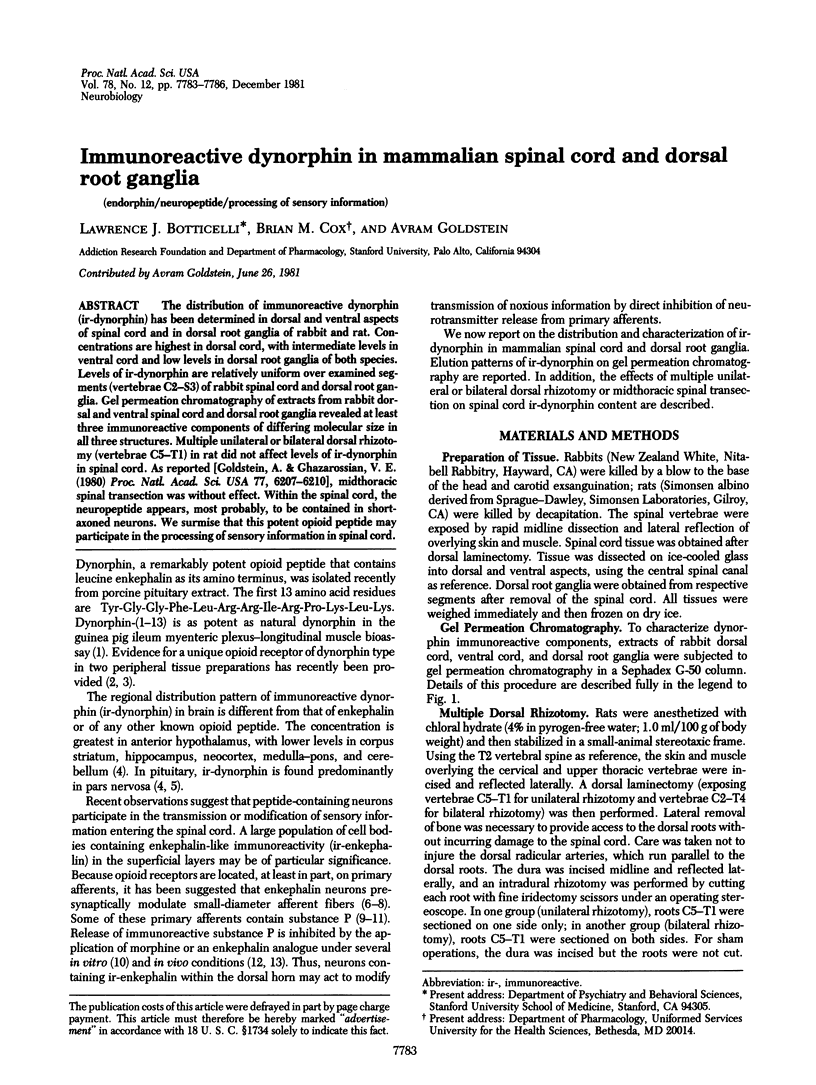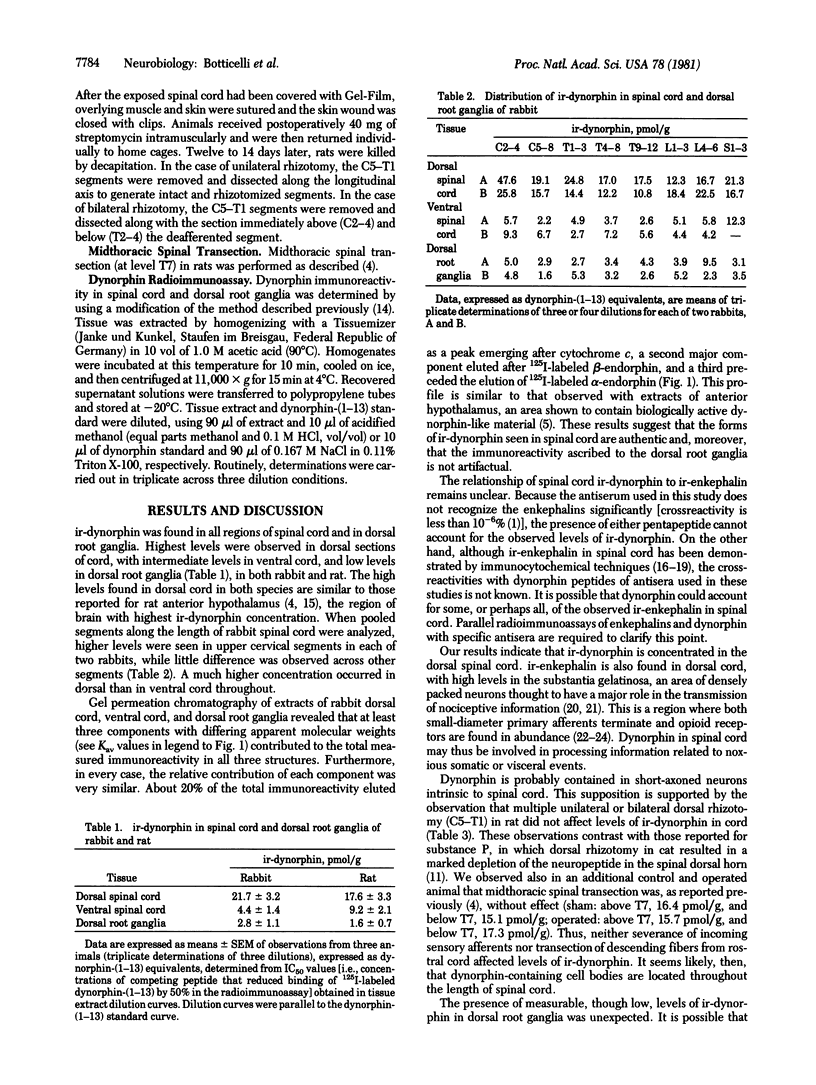Abstract
The distribution of immunoreactive dynorphin (ir-dynorphin) has been determined in dorsal and ventral aspects of spinal cord and in dorsal root ganglia of rabbit and rat. Concentrations are highest in dorsal root, with intermediate levels in ventral cord and low levels in dorsal root ganglia of both species. Levels of ir-dynorphin are relatively uniform over examined segments (vertebrae C2-S3) of rabbit spinal cord and dorsal root ganglia. Gel permeation chromatography of extracts from rabbit dorsal and ventral spinal cord and dorsal root ganglia revealed at least three immunoreactive components of differing molecular size in all three structures. Multiple unilateral or bilateral dorsal rhizotomy (vertebrae C5-T1) in rat did not affect levels of ir-dynorphin in spinal cord. As reported [Goldstein, A. & Ghazarossian, V. E. (1980) Proc. Natl. Acad. Sci. USA 77, 6207-6210], midthoracic spinal transection was without effect. Within the spinal cord, the neuropeptide appears, most probably, to be contained in short-axoned neurons. We surmise that this potent opioid peptide may participate in the processing of sensory information in spinal cord.
Full text
PDF



Selected References
These references are in PubMed. This may not be the complete list of references from this article.
- Atweh S. F., Kuhar M. J. Autoradiographic localization of opiate receptors in rat brain. I. Spinal cord and lower medulla. Brain Res. 1977 Mar 18;124(1):53–67. doi: 10.1016/0006-8993(77)90863-0. [DOI] [PubMed] [Google Scholar]
- Chavkin C., Goldstein A. Demonstration of a specific dynorphin receptor in guinea pig ileum myenteric plexus. Nature. 1981 Jun 18;291(5816):591–593. doi: 10.1038/291591a0. [DOI] [PubMed] [Google Scholar]
- Elde R., Hökfelt T., Johansson O., Terenius L. Immunohistochemical studies using antibodies to leucine-enkephalin: initial observations on the nervous system of the rat. Neuroscience. 1976 Aug;1(4):349–351. doi: 10.1016/0306-4522(76)90063-4. [DOI] [PubMed] [Google Scholar]
- Fields H. L., Emson P. C., Leigh B. K., Gilbert R. F., Iversen L. L. Multiple opiate receptor sites on primary afferent fibres. Nature. 1980 Mar 27;284(5754):351–353. doi: 10.1038/284351a0. [DOI] [PubMed] [Google Scholar]
- Ghazarossian V. E., Chavkin C., Goldstein A. A specific radioimmunoassay for the novel opioid peptide dynorphin. Life Sci. 1980 Jul 7;27(1):75–86. doi: 10.1016/0024-3205(80)90021-1. [DOI] [PubMed] [Google Scholar]
- Goldstein A., Ghazarossian V. E. Immunoreactive dynorphin in pituitary and brain. Proc Natl Acad Sci U S A. 1980 Oct;77(10):6207–6210. doi: 10.1073/pnas.77.10.6207. [DOI] [PMC free article] [PubMed] [Google Scholar]
- Goldstein A., Tachibana S., Lowney L. I., Hunkapiller M., Hood L. Dynorphin-(1-13), an extraordinarily potent opioid peptide. Proc Natl Acad Sci U S A. 1979 Dec;76(12):6666–6670. doi: 10.1073/pnas.76.12.6666. [DOI] [PMC free article] [PubMed] [Google Scholar]
- Hiller J. M., Simon E. J., Crain S. M., Peterson E. R. Opiate receptors in cultures of fetal mouse dorsal root ganglia (DRG) and spinal cord: predominance in DRG neurites. Brain Res. 1978 Apr 28;145(2):396–400. doi: 10.1016/0006-8993(78)90875-2. [DOI] [PubMed] [Google Scholar]
- Hunt S. P., Kelly J. S., Emson P. C. The electron microscopic localization of methionine-enkephalin within the superficial layers (I and II) of the spinal cord. Neuroscience. 1980;5(11):1871–1890. doi: 10.1016/0306-4522(80)90036-6. [DOI] [PubMed] [Google Scholar]
- Hökfelt T., Kellerth J. O., Nilsson G., Pernow B. Experimental immunohistochemical studies on the localization and distribution of substance P in cat primary sensory neurons. Brain Res. 1975 Dec 19;100(2):235–252. doi: 10.1016/0006-8993(75)90481-3. [DOI] [PubMed] [Google Scholar]
- Hökfelt T., Ljungdahl A., Terenius L., Elde R., Nilsson G. Immunohistochemical analysis of peptide pathways possibly related to pain and analgesia: enkephalin and substance P. Proc Natl Acad Sci U S A. 1977 Jul;74(7):3081–3085. doi: 10.1073/pnas.74.7.3081. [DOI] [PMC free article] [PubMed] [Google Scholar]
- Höllt V., Haarmann I., Bovermann K., Jerlicz M., Herz A. Dynorphin-related immunoreactive peptides in rat brain and pituitary. Neurosci Lett. 1980 Jun;18(2):149–153. doi: 10.1016/0304-3940(80)90318-3. [DOI] [PubMed] [Google Scholar]
- Jessell T. M., Iversen L. L. Opiate analgesics inhibit substance P release from rat trigeminal nucleus. Nature. 1977 Aug 11;268(5620):549–551. doi: 10.1038/268549a0. [DOI] [PubMed] [Google Scholar]
- Lamotte C., Pert C. B., Snyder S. H. Opiate receptor binding in primate spinal cord: distribution and changes after dorsal root section. Brain Res. 1976 Aug 13;112(2):407–412. doi: 10.1016/0006-8993(76)90296-1. [DOI] [PubMed] [Google Scholar]
- Mudge A. W., Leeman S. E., Fischbach G. D. Enkephalin inhibits release of substance P from sensory neurons in culture and decreases action potential duration. Proc Natl Acad Sci U S A. 1979 Jan;76(1):526–530. doi: 10.1073/pnas.76.1.526. [DOI] [PMC free article] [PubMed] [Google Scholar]
- Pert C. B., Kuhar M. J., Snyder S. H. Autoradiograhic localization of the opiate receptor in rat brain. Life Sci. 1975 Jun 15;16(12):1849–1853. doi: 10.1016/0024-3205(75)90289-1. [DOI] [PubMed] [Google Scholar]
- Sar M., Stumpf W. E., Miller R. J., Chang K. J., Cuatrecasas P. Immunohistochemical localization of enkephalin in rat brain and spinal cord. J Comp Neurol. 1978 Nov 1;182(1):17–37. doi: 10.1002/cne.901820103. [DOI] [PubMed] [Google Scholar]
- Simantov R., Kuhar M. J., Uhl G. R., Snyder S. H. Opioid peptide enkephalin: immunohistochemical mapping in rat central nervous system. Proc Natl Acad Sci U S A. 1977 May;74(5):2167–2171. doi: 10.1073/pnas.74.5.2167. [DOI] [PMC free article] [PubMed] [Google Scholar]
- Takahashi T., Otsuka M. Regional distribution of substance P in the spinal cord and nerve roots of the cat and the effect of dorsal root section. Brain Res. 1975 Apr 4;87(1):1–11. doi: 10.1016/0006-8993(75)90774-x. [DOI] [PubMed] [Google Scholar]
- Watson S. J., Akil H., Ghazarossian V. E., Goldstein A. Dynorphin immunocytochemical localization in brain and peripheral nervous system: preliminary studies. Proc Natl Acad Sci U S A. 1981 Feb;78(2):1260–1263. doi: 10.1073/pnas.78.2.1260. [DOI] [PMC free article] [PubMed] [Google Scholar]
- Wüster M., Schulz R., Herz A. Highly specific opiate receptors for dynorphin-(1-13) in the mouse vas deferens. Eur J Pharmacol. 1980 Mar 21;62(2-3):235–236. doi: 10.1016/0014-2999(80)90283-6. [DOI] [PubMed] [Google Scholar]
- Yaksh T. L., Jessell T. M., Gamse R., Mudge A. W., Leeman S. E. Intrathecal morphine inhibits substance P release from mammalian spinal cord in vivo. Nature. 1980 Jul 10;286(5769):155–157. doi: 10.1038/286155a0. [DOI] [PubMed] [Google Scholar]
- Yaksh T. L., Rudy T. A. Analgesia mediated by a direct spinal action of narcotics. Science. 1976 Jun 25;192(4246):1357–1358. doi: 10.1126/science.1273597. [DOI] [PubMed] [Google Scholar]
- Yaksh T. L., Rudy T. A. Narcotic analgestics: CNS sites and mechanisms of action as revealed by intracerebral injection techniques. Pain. 1978 Apr;4(4):299–359. doi: 10.1016/0304-3959(77)90145-2. [DOI] [PubMed] [Google Scholar]


